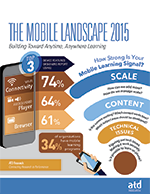ATD Blog
The Mobile Learning Landscape 2015
Wed May 27 2015


Mobile devices are everywhere, with 64 percent of American adults owning a smartphone and 42 percent owning a tablet, so it’s no surprise that learning professionals are extremely interested in the use of mobile technologies for training delivery.
Understanding the growing importance of mobile technologies in learning, ATD and the Institute for Corporate Productivity (i4cp) recently released the report, The Mobile Landscape 2015: Building Toward Anytime, Anywhere Learning. This research began with a survey fielded in February 2015, to which 411 learning and business professionals responded. ATD and i4cp also administered surveys on the topic of mobile learning in 2010 and 2013.
Mobile Learning Isn’t Widespread Yet
The use of mobile learning has grown considerably in the last half decade, but there is still plenty of room for expansion. The report found that only 34 percent of organizations have mobile learning programs in place. In 2010, mobile learning was actively in use in 15 percent of organizational learning functions. In 2013, ATD and i4cp asked learning professionals if their organizations made any internal learning content available through mobile devices, and 31 percent responded “yes.”
How Are Organizations Using Mobile Learning?
What does mobile learning in 2015 look like? Mobile learning is most likely to be used to support sales functions, with 56 percent of respondents from organizations with mobile learning programs reporting that their organization’s program was designed to support sales. This is a logical finding given that many salespeople spend most of their working hours away from the office and are most easily reached via smartphones and tablets.
In addition, when employees use mobile learning, chances are they will access the web or play audio and video content. Nearly three-quarters of mobile learning programs leverage wi-fi connectivity, and more than six in 10 use audio and video players.
Where Is Mobile Learning Headed and What Can Learning Do?
The report suggests that even though mobile learning isn’t used in most organizations, it is on the brink of expansion. Among those organizations without mobile learning programs, more than half have plans to implement one in the future.
Indeed, some learning leaders suggest that, in order to stay relevant to the business, embracing mobile technologies is critical. As Geoff Stead, the senior director of mobile learning for the high-performance technology firm Qualcomm suggested, “Our employees are surrounded by exciting technologies every day: amazing consumer technology, cool public apps and a huge array of digital distractions in their daily lives. My team is in a race to bring those same ideas into our internal learning…If we’re not racing alongside, staying useful and relevant, we’ll be left behind.”
Based on his experiences, Stead suggests focusing on technical issues (such as whether it’s possible to learn something on the phone) at the early stages, then focusing on content and scale.
Want to Learn More?
The full report is available at www.td.org/mobilelandscape. Members have access to a free whitepaper version of the report, and an infographic is free to everyone.
You've Reached ATD Member-only Content
Become an ATD member to continue
Already a member?Sign In
